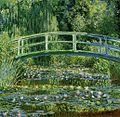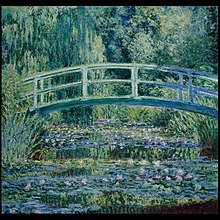File:Water-Lilies-and-Japanese-Bridge-(1897-1899)-Monet.jpg
Jump to navigation
Jump to search

Size of this preview: 617 × 599 pixels. Other resolutions: 247 × 240 pixels | 494 × 480 pixels | 791 × 768 pixels | 1,031 × 1,001 pixels.
Original file (1,031 × 1,001 pixels, file size: 381 KB, MIME type: image/jpeg)
File history
Click on a date/time to view the file as it appeared at that time.
| Date/Time | Thumbnail | Dimensions | User | Comment | |
|---|---|---|---|---|---|
| current | 20:57, 19 January 2009 |  | 1,031 × 1,001 (381 KB) | Krscal | {{Information |Description={{en|1=Water Lilies and Japanese Bridge (1897-1899) by Claude Monet Princeton University Art Museum}} |Source=the-athenaeum.org http://www.the-athenaeum.org/art/full.php?ID=3788 |Author=Claude Monet |Date=1897-1899 |Permission= |
File usage
The following page uses this file:
Global file usage
The following other wikis use this file:
- Usage on ceb.wikipedia.org
- Usage on cs.wikipedia.org
- Usage on cy.wikipedia.org
- Usage on en.wikipedia.org
- Usage on et.wikipedia.org
- Usage on fr.wikivoyage.org
- Usage on ja.wikipedia.org
- Usage on kbp.wikipedia.org
- Usage on lv.wikipedia.org
- Usage on pl.wikipedia.org
- Usage on pt.wikipedia.org
- Usage on ro.wikipedia.org
- Usage on sl.wikipedia.org
- Usage on sq.wikipedia.org
- Usage on sv.wikipedia.org
- Usage on ta.wikipedia.org
- Usage on vi.wikipedia.org



